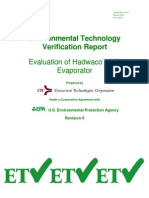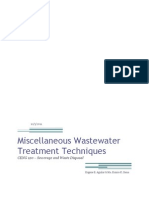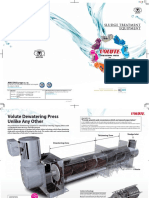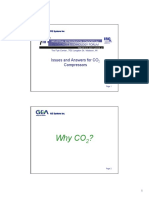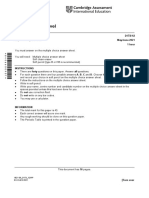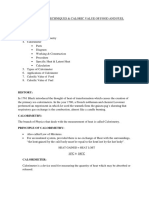Main Catalogue
Main Catalogue
Uploaded by
Mohamed SalahCopyright:
Available Formats
Main Catalogue
Main Catalogue
Uploaded by
Mohamed SalahCopyright
Available Formats
Share this document
Did you find this document useful?
Is this content inappropriate?
Copyright:
Available Formats
Main Catalogue
Main Catalogue
Uploaded by
Mohamed SalahCopyright:
Available Formats
Drilling rigs wastewater:
With water being more and more costly due to scarcity, more operators become aware that not only is reusing treated wastewater
wastewate
cost efficient but also key to sustain our environment. As these drilling locations can be sometimes far away from cities and water
sources are therefore many miles away, water can be very expensive. This makes it even more important to reuse water. In addition
addi
to that, the drilling companies become less dependent on outside sources that control the water
water.
Advantages of our ClearFox products:
Low operation/energy cost
Very mobile, e, no infrastructure required (only solid ground)
It is flexible, as systems can be designed as complete waste water treatment plants or hybrid systems, depending on the
requirements
Odorless
Fully automatic with little input of operator required
Can be easily
sily dismantled and relocated to a new location
Minimum of maintenance, can be taught to anyone
without experience in this sector
Can also be rented/leased
Made in Germany, very robust against all weather influences
Warranty of 20 years
Water uses in the oil & gas industry:
In drilling operations, water is used for the mixing of drilling mud, boiler feed water, cement and many more. It is safe to say that
water is a necessity for many of the drilling operation functions.
PPU Umwelttechnik GmbH Carl – Kolb Str. 6, 95448 Bayreuth info@clearfox.com
+49 (0)921-150 63 990 +49 (0)921-150 63 999
1
ClearFox® CFC-Flotation Unit
DAF (dissolved air flotation) modular system
Compact DAF-unit, designed for efficient treatment of any type of industrial wastewater
Application: Industrial wastewater treatment
Application Sizes: 1m³ /h to 250m³ /h wastewater (20 h operation)
Retrofitting: yes
Datasheet: ClearFox DAF
Manufactured in: Germany
Special features are:
The ClearFox® dissolved air flotation series is characterized by its
extremely robust, space-saving design. It can be supplied skid mounted
or fully containerized. The great success of this technology is based on
its simple and cost effective operation. The systems have been installed
in many major European food producing facilities and industrial
wastewater applications globally. The ClearFox® DAF modules can be
supplied with other ClearFox® modules as part of a larger solution or
as standalone solutions.
Benefits of the ClearFox®flotation technology are as follows:
Highly efficient in COD/BOD/FOGs reduction (up to 99%)
Self cleaning patented design [no mechanical scraper required for many applications]
Two stage DAF – not just single stage like standard DAF systems
Lower chemical requirements than standard DAF systems
Made from PP which has a higher resistance to many liquids/chamicals when compared to SS
Totally automatic operation
Standardized manufactured models
Compact design with smaller footprint than standard DAF systems
Clog-free saturation system
Pre thickened flotation sludge produced
Easy to service
PPU Umwelttechnik GmbH Carl – Kolb Str. 6, 95448 Bayreuth info@clearfox.com
+49 (0)921-150 63 990 +49 (0)921-150 63 999
2
Flotation plants are especially suitable for wastewaters from operation
and production processes such as:
Meat processing / Slaughterhouses
Dairy factory / Milk production
Wine / Juice production
Breweries
Canning factory
Commercial kitchen / Canteens
Restaurants
Cosmetics production
Food transport company
Chemical industry
Pharmaceutical industry
Petrochemical industry
Textile industry
Paper industry
Municipal wastewater cleaning
Options:
Containerised
Skid mounted
pH adjustment module
Precipitation module
Flocculation module
GSM/Remote monitoring
Functionality:
The ClearFox flotation plant is fully automatic. A specific, clog-free helical rotor pump leads the water from
the collection container (collection tank or skimming tank provided by the customer) to the reactor.
The wastewater flows through a pH-regulation section where pH-fluctuations are compensated. Then,
wastewater flows continuously into the reactor. Additives are developed in a polymer preparation station in
order to aid the flocculation and flotation process.
These are mixed fully automatically into the inflowing waste water with flocculators. A multiphase pump
saturates the outlet of the water continuously with air, which is then recirulated into the reactor. The pressure
release causes a flotation of the floatable particles. These accumulate in the upper section of the reactor and
are separated by a self cleaning process, or with a scraper for special applications. Flotation sludge is
removed via a cone-shaped opening with compressed air.
PPU Umwelttechnik GmbH Carl – Kolb Str. 6, 95448 Bayreuth info@clearfox.com
+49 (0)921-150 63 990 +49 (0)921-150 63 999
3
Operation:
The plant is fully automated and depending on the waste water flow, a high quality effluent quality is
achieved at all times. The system is very robust, and uses no clearing devices with movable chains or
scrapers (needing lubricants etc.), that require constant maintenance.
The Systems have proven their reliability in many industries over the years, particularly in the food industry.
Cleaning efficiency:
The Cleaning-efficiency depends on how high the degradation rate of the waste water is and operator
behavior.
The effluent is largely free from fats and purified to an indirect discharge quality, pH 6.5-7, COD 1.500 mg /
l, BOD 1.000 mg / l, TSS 500 mg / l. There is no change in temperature as a result of the process, and the
effluent quality is suitable for biological post-cleaning.
Typical cleaning performances in the milk / meat industry in the DELIVERY / PROCESS are as an example
[mg / l] COD ZU: 3000-7000 / AB: 1000-1500, BOD ZU: 2000-3500 / AB: 700-1000, TSS ZU: 300-700 /
AB: 250-500
Installation:
The DAF System includes:
flotation reactor
feed pump eccentric screw for inflow
feed pump eccentric screw for sludge feed
small interim sludge storage tank
dosing / mixing line
polymer mixing station
dosing pumps (2 x)
suction lances for chemical canister
multiphase pump
pH neutralization
room aerator and heater (frost protection)
control unit
If not installed in a container, the scope of supply consists of three parts that can be set up freely and are
mounted on skids. These parts (pump station, flotation station, dosing station), as well as the control cabinet,
can be easily transported with forklifts.
The base area for the system components must be firm and level (foundations), the environment dry,
covered, dew protected; in closed structures with multiple air changes according to the regional regulations.
PPU Umwelttechnik GmbH Carl – Kolb Str. 6, 95448 Bayreuth info@clearfox.com
+49 (0)921-150 63 990 +49 (0)921-150 63 999
4
Consumer materials:
In order to regulate the pH in the water, acids or alkalics are added into the system. The system also has a
metering system for fission products (flocculant) and polymer (flocculant-help). The specific consumption is
determined in the laboratory and this is optimized by us after the start up of system.
Residues, sludge:
In the ClearFox® dissolved air flotation system, fats and oils along with other dissolved substances which
are extracted, are removed from the wastewater as flotation sludge. The resulting amount is dependent on the
concentration of such substances in the wastewater. It can be assumed that about 40 to 60 liters of flotation
sludge per m³ of wastewater are produced at average concentrations. This is approximately 4 to 6 % of the
volume of the waste water entering the DAF system.
The flotation sludge further dehydrates during storage, thus the longer it is stored, the less water content the
sludge has. It is recommended to use enclosed structures /systems to avoid odour problems.
PPU Umwelttechnik GmbH Carl – Kolb Str. 6, 95448 Bayreuth info@clearfox.com
+49 (0)921-150 63 990 +49 (0)921-150 63 999
11
2
ClearFox® FBS Plant
ClearFox® FBS (Fluidised Bed System)
Application: Domestic – Municipal – Industrial treatment
Retrofitting: Yes
Manufactured in: Germany
Functionality:
The plant always includes:
Primary cleaning stage
Fluidized bed reactor
Secondary sedimentation chamber
In the FBS there are free floating support medium (small plastic form parts) or particles (produced from UV-stabilized
polyethylene), on which bacteria grow. A biological layer (micro-organic colonization) forms on this medium after a start-up
period. The biofilm which consists mainly of aerobic organisms, transforms the organic contaminants contained in the wastewater
into sedimentary and mineral substances. The wastewater is serrated intermittently and the aeration system installed in the tank
supplies the organisms with sufficient oxygen and in addition, the aeration process causes a current that moves the fluid containing
the biofilm medium and the entire content of the reactor is blended.
This technology requires no rotating parts in the wastewater. Return sludge is transported via maintenance-free airlift-pump,
operated with compressed air. The blower supplying the oxygen is placed outside the container near the control cabinet.
Mechanical cleaning stage:
Prior to the FBR biological stage, the raw wastewater is separated in this first stage by either mechanical separation or primary
settlement depending on the project size. Particles in the wastewater that are smaller than 3mm pass through the screen and enter
the FBS. The natural wastewater accumulation flows freely through the plant. An integrated restriction valve controls wastewater
flow to prevent shock loading and to make sure that the flow is equalized in order to optimize the physical and biological
processes.
PPU Umwelttechnik GmbH Carl – Kolb Str. 6, 95448 Bayreuth info@clearfox.com
+49 (0)921-150 63 990 +49 (0)921-150 63 999
2
Fluidized bed reactor:
In the fluidized bed container there are free floating support media
(small plastic form parts) or particles (produced from UV-stabilized
polyethylene), on which bacteria grow. A biological layer (micro-
organic colonization) forms on this medium after a start-up period.
The biofilm which consists mainly of aerobic organisms transforms
the organic contaminants contained in the wastewater into
sedimentary and mineral substances. The wastewater is aerated
intermittently and the aeration system installed in the tank, supplies
the organisms with sufficient oxygen. The aeration also causes a
current that moves the fluid containing the biofilm medium and the
entire content of the reactor is blended.
This technology requires no rotating parts in the wastewater. Sludge
is transported via a maintenance-free airlift-pump, operated with
compressed air back to the primary settlement zone. The blower supplying the oxygen is placed outside the container near the
control cabinet.
Secondary sedimentation chamber:
In the secondary sedimentation chamber, the cleaned wastewater is separated from the bio mass by sedimentation. At
preprogrammed intervals, an airlift-pump returns sedimented biomass as surplus sludge back into the pre-chamber as programmed.
Benefits of fluidized bed plants:
Low sludge volume
Good cleaning performance
Good cleaning performance even with underload
Simple retrofitting possible
Maintenance required only once per year
Proven system
The main advantage of a ClearFox fluidised bed procedure is the high biomass concentration (>21gTS/L) which allows for a small
reactor design. This saves costs while reaching a high cleaning performance.
PPU Umwelttechnik GmbH Carl – Kolb Str. 6, 95448 Bayreuth info@clearfox.com
+49 (0)921-150 63 990 +49 (0)921-150 63 999
1
ClearFox® Containerised systems
Modular sewage treatment plant
A containerized mobile waste water treatment plant is
a packaged system where all wastewater treatment
equipment is completely preinstalled in ISO shipping
containers.
The modular container system with the various
components of a waste water plant are adjusted to
customer requirements and can be easily transported
by land and sea. As all the waste water treatment
equipment is preinstalled and factory tested, onsite
installation work is limited and basically Plug & Play.
RE
Application Size:
There is no limit or restriction on the size of the project
that our containerised systems can be utilized for, as the
system is modular.
Waste water treatment systems from 50 to 20.000
persons, or 8-800m3 of wastewater per day have been
commissioned. For larger applications it may become
more financially viable to make use of SBR equipment
solutions in tanks and structures that are constructed
onsite. Any effluent quality can be achieved.
PPU Umwelttechnik GmbH Carl – Kolb Str. 6, 95448 Bayreuth info@clearfox.com
+49 (0)921-150 63 990 +49 (0)921-150 63 999
2
Advantages of a ClearFox® packaged wastewater treatment:
Market leading, state of the art technology is built into our container solutions, which are manufactured in a
quality controlled environment and are factory tested.
The complete system with all its components is provided from one supplier, thus limiting financial risk.
It is made in Germany, with 20 years warranty on new packaged waste water treatment systems.
The waste water container treatment plants are suitably designed for all climate zones and achieve maximum
efficiency in each process step.
The system can easily be transported by land or sea and is easily setup in isolated remote and off the grid
areas.
Low costs for scheduling and construction, as no infrastructure or buildings are required. Only a solid base or
foundation is needed on which to place the containers.
The solution is modular, fully automatic plug & play and can be tailored to the specific local conditions and
project requirements.
Rapid installation and setup of the system as it is delivered with all equipment preinstalled. Simply connect
the system to the electricity supply, then connect the inlets and outlets.
It can be rapidly dismantled to be quickly and easily relocated to a new location.
Low energy costs due to the integrated energy saving mode.
Imperceptible noise as the entire container treatment plant is enclosed.
Standard, locally obtainable spare parts can be used for maintenance, thus saving time and money.
Can be used as a fixed or temporary solution for any existing treatment plant, in a supporting function, during
improvements being undertaken [new, upgrade, bypass].
The modules can be added on to upgrade existing WWTPs to meet new emission limits.
It is flexible, as systems can be designed as complete waste water treatment plants or hybrid systems,
depending on the requirements.
Designed for waste water treatment, sludge treatment and industrial water treatment for different medium
and large scale applications such as the food industry or for remote communities without access to a
municipal sewage system.
PPU Umwelttechnik GmbH Carl – Kolb Str. 6, 95448 Bayreuth info@clearfox.com
+49 (0)921-150 63 990 +49 (0)921-150 63 999
2
Applications are:
Industrial
al waste water treatment solutions for any industrial wastewater [food, drink, dairy, auto, etc]
Municipal: during upgrade or maintenance work on existing sewage treatment plants
Communal: remote communities without access to a municipal sewage system
Replacement
acement or relief overflow of pond treatment plants
For regional tourist facilities to provide extra capacity
Complete solutions for medium scale applications such as hotels, resorts, housing developments, schools,
hospitals, etc.
Remote tourist facilities,, lodges, camping sites and military camps.
Refugee, asylum and worker camps
Offshore applications eg. on oil rigs
mobile solutions for remote construction sites, drilling and mining sites
Agricultural: Treatment of slurry and digestate from Biogas plants
Emergency wastewater treatment following catastrophes and disasters
Infrastructure for large events
Temporary solutions, rented sewage treatment plants, leased sewage treatment plants
In connection with portable toilets or washroom container
Specialist industrial
ustrial wastewater solutions and pilot scale WWTPs for non standard applications [landfill, oil
and gas, power plants, etc]
PPU Umwelttechnik GmbH Carl – Kolb Str. 6, 95448 Bayreuth info@clearfox.com
+49 (0)921-150 63 990 +49 (0)921-150 63 999
You might also like
- Hooke's Law Lab ReportDocument5 pagesHooke's Law Lab Reportdanproxy100% (1)
- 1.0-Introduction: Technical Proposal R.O. SystemDocument13 pages1.0-Introduction: Technical Proposal R.O. SystemZarkKhan100% (1)
- CAP 15 - 3 Design of Water Resource Recovery Facilities, Sixth Edition Nitrogen-Removal-Sidestream-Process-DesignDocument4 pagesCAP 15 - 3 Design of Water Resource Recovery Facilities, Sixth Edition Nitrogen-Removal-Sidestream-Process-DesignNICOLAS SANCHEZ GOMEZNo ratings yet
- Effective Screen Area CalculationsDocument6 pagesEffective Screen Area CalculationsAwtar SinghNo ratings yet
- Shortcut Nitrogen Removal-Nitrite Shunt and DeammonificationFrom EverandShortcut Nitrogen Removal-Nitrite Shunt and DeammonificationNo ratings yet
- LEDS Product SheetDocument4 pagesLEDS Product SheetMohamed SalahNo ratings yet
- MECH 3002 Assignment 2 2017Document3 pagesMECH 3002 Assignment 2 2017John100% (1)
- Lamella Clarifier SeDocument1 pageLamella Clarifier SeJotheeswaranNo ratings yet
- RWT Ro188. (500 LPH)Document5 pagesRWT Ro188. (500 LPH)Rinse Water TechnologyNo ratings yet
- MBR OPEX - The Theory of Running CostsDocument6 pagesMBR OPEX - The Theory of Running CostsJeremy DudleyNo ratings yet
- 06 VR HadwacoDocument43 pages06 VR HadwacoLuis ValdezNo ratings yet
- STP Biochip Package PlantDocument2 pagesSTP Biochip Package PlantDavid Lambert100% (1)
- What Sets The SaltMaker Apart 1Document10 pagesWhat Sets The SaltMaker Apart 1Furi Sri RahimahNo ratings yet
- Miscellaneous Waste Water Treatment Techniques-HandoutsDocument11 pagesMiscellaneous Waste Water Treatment Techniques-HandoutsNiz SienaNo ratings yet
- MBR Design Consideration Are KeyDocument8 pagesMBR Design Consideration Are KeyNghi VoNo ratings yet
- Sedron Services Sumner Washington - ST 6267 - Draft O&M Manual - Emailed 1-26-21Document31 pagesSedron Services Sumner Washington - ST 6267 - Draft O&M Manual - Emailed 1-26-21Vishal shuklaNo ratings yet
- Savi General CatalogueDocument8 pagesSavi General CataloguecristyryeNo ratings yet
- Memcor UF CS CP Changi Singapore 45 D03679 enDocument2 pagesMemcor UF CS CP Changi Singapore 45 D03679 enRiannaNo ratings yet
- AMCON Brochure 2018Document10 pagesAMCON Brochure 2018Hemant KaleNo ratings yet
- Ultrafiltration For Oily Industrial Water: Separation Dynamics Paper SeriesDocument13 pagesUltrafiltration For Oily Industrial Water: Separation Dynamics Paper SeriesböhmitNo ratings yet
- Brochure RevisedDocument22 pagesBrochure RevisedbrijeshNo ratings yet
- Case Study Fujifilm MBR v01Document2 pagesCase Study Fujifilm MBR v01كرم عمروNo ratings yet
- Brochure SuperSettlerDocument8 pagesBrochure SuperSettlerJesús RiberaNo ratings yet
- Environment Protection EngineeringDocument12 pagesEnvironment Protection Engineeringtyul_tiaNo ratings yet
- Non-Uniform Open Channel Flow - Surface Profile Calculations - S.I. UnitsDocument32 pagesNon-Uniform Open Channel Flow - Surface Profile Calculations - S.I. UnitsdiegoNo ratings yet
- Anaerobic Biological Wastewater TreatmentDocument4 pagesAnaerobic Biological Wastewater TreatmentKhalilRoumaniNo ratings yet
- Is 13268 1992 PDFDocument19 pagesIs 13268 1992 PDFMuhammad ImranNo ratings yet
- D4F869 Aeration Tank Operation Calculations Si UnitsDocument2 pagesD4F869 Aeration Tank Operation Calculations Si UnitsSanjeev KachharaNo ratings yet
- Salsnes Filter SF EnglishDocument2 pagesSalsnes Filter SF EnglishGUZMANNo ratings yet
- Common Mistakes in Design, Use of Reverse Osmosis SystemsDocument4 pagesCommon Mistakes in Design, Use of Reverse Osmosis SystemsihllhmNo ratings yet
- FRP Tanks Comp PDFDocument1 pageFRP Tanks Comp PDFHRK65No ratings yet
- Sanitary Butterfly Valve WellgreenDocument12 pagesSanitary Butterfly Valve WellgreenRoger ChenNo ratings yet
- Formation Filtres Leopold (Xylem) PDFDocument40 pagesFormation Filtres Leopold (Xylem) PDFManoakiNo ratings yet
- Vepl 5081 TC L 0516Document16 pagesVepl 5081 TC L 0516Nakclean Water SolutionsNo ratings yet
- Pilot Units From LiqTech - v2 PDFDocument2 pagesPilot Units From LiqTech - v2 PDFGabriel Montoya CorreaNo ratings yet
- Chemicals Zetag MSDS Powder Zetag 4190 - 0810Document6 pagesChemicals Zetag MSDS Powder Zetag 4190 - 0810PromagEnviro.comNo ratings yet
- B7 PROJECT REPORT NewDocument21 pagesB7 PROJECT REPORT NewvijayNo ratings yet
- Quotation For DMF and ACFDocument3 pagesQuotation For DMF and ACFAnshika RaiNo ratings yet
- Rotary Sludge Dryer Ver. 1.3Document2 pagesRotary Sludge Dryer Ver. 1.3TG-MachinesNo ratings yet
- Biodek CatalogueDocument17 pagesBiodek CatalogueSourabh ManujaNo ratings yet
- SMART Digital - DDA With Profibus DP / Modbus Rtu / Profinet Io / Modbus TCPDocument2 pagesSMART Digital - DDA With Profibus DP / Modbus Rtu / Profinet Io / Modbus TCPRyan GohNo ratings yet
- Dimensioning and Design of Nitrogen - Stefan RettigDocument33 pagesDimensioning and Design of Nitrogen - Stefan RettigNguyen Phuc PhamNo ratings yet
- Presentation of Apex Consultants - NewDocument20 pagesPresentation of Apex Consultants - NewSudhirNo ratings yet
- 250 LPH Ro PlantDocument4 pages250 LPH Ro PlantKamatchi NathanNo ratings yet
- 46 07 13 - Packaged Water Treatment Equipment PDFDocument9 pages46 07 13 - Packaged Water Treatment Equipment PDFmasoodaeNo ratings yet
- By: Michael Sam Aradillos Vincent VasquezDocument11 pagesBy: Michael Sam Aradillos Vincent VasquezClive Delos ReyesNo ratings yet
- Quotation For 35 KLD STP & 10 KLD Etp Plant-Shree Ram Hospital - Dt. 14-06-2024Document7 pagesQuotation For 35 KLD STP & 10 KLD Etp Plant-Shree Ram Hospital - Dt. 14-06-2024Vishal shuklaNo ratings yet
- Design and Operation Considerations For Condensate Polishing - T5S5O3-paper PDFDocument17 pagesDesign and Operation Considerations For Condensate Polishing - T5S5O3-paper PDFNhhVuNo ratings yet
- The Design and Testing of A Continuous Effluent Sterilization System For Liquid WasteDocument8 pagesThe Design and Testing of A Continuous Effluent Sterilization System For Liquid Wastepeyman mahinsaNo ratings yet
- Module - 9 Secondary Treatment AS, EAAS, SBRDocument39 pagesModule - 9 Secondary Treatment AS, EAAS, SBRFaran Masood100% (1)
- Automated Sand Gravity Sand Filter SystemDocument58 pagesAutomated Sand Gravity Sand Filter SystemMichael100% (1)
- MBR - Industrial WW AE 02Document12 pagesMBR - Industrial WW AE 02transilvanpopNo ratings yet
- SEKO Solenoid Dosing Pumps Kompact SeriesDocument3 pagesSEKO Solenoid Dosing Pumps Kompact SeriesmauiraNo ratings yet
- 7.5 KLHR MEE Offer (5%)Document10 pages7.5 KLHR MEE Offer (5%)kezaihrajNo ratings yet
- Rotating Biological ContactorsDocument18 pagesRotating Biological Contactorsjjiménez_142046No ratings yet
- Presentation 2Document23 pagesPresentation 2amandaNo ratings yet
- MicrofilterDocument17 pagesMicrofilterArrianne Jaye MataNo ratings yet
- Project Profile On Battery Water PDFDocument2 pagesProject Profile On Battery Water PDFSuresh KaushikNo ratings yet
- Product Catalog: Compact Screen, Single Screen & Multi Screen FiltersDocument26 pagesProduct Catalog: Compact Screen, Single Screen & Multi Screen FiltersLuan NguyenNo ratings yet
- TIC Outlook 2018: Trends and Prospects in The Testing, Inspection and Certification SectorDocument11 pagesTIC Outlook 2018: Trends and Prospects in The Testing, Inspection and Certification SectorMohamed SalahNo ratings yet
- Revised Marketing PlanDocument33 pagesRevised Marketing PlanMohamed SalahNo ratings yet
- Novel Coronavirus (Sars-Cov-2) Antibody (Igm / Igg) TestDocument29 pagesNovel Coronavirus (Sars-Cov-2) Antibody (Igm / Igg) TestMohamed SalahNo ratings yet
- Published On 24 March 2020: Points 4, 6, 7 and 8 Were AmendedDocument5 pagesPublished On 24 March 2020: Points 4, 6, 7 and 8 Were AmendedMohamed SalahNo ratings yet
- 3 Anders SouzaMonteiro Rouviere FINALDocument26 pages3 Anders SouzaMonteiro Rouviere FINALMohamed SalahNo ratings yet
- InvestorDays Market VDEFDocument18 pagesInvestorDays Market VDEFMohamed SalahNo ratings yet
- Compac MarbleDocument40 pagesCompac MarbleMohamed SalahNo ratings yet
- 2010 Natural Stone EU Market SurveyDocument40 pages2010 Natural Stone EU Market SurveyMohamed SalahNo ratings yet
- Juthathip Thanatawee: ObjectiveDocument6 pagesJuthathip Thanatawee: ObjectiveMohamed SalahNo ratings yet
- TransducersDocument19 pagesTransducersTsihatesfaNo ratings yet
- Majestic Outdoor Fireplace ManualDocument20 pagesMajestic Outdoor Fireplace Manualdenizen27No ratings yet
- 7 Principles of CuttingDocument9 pages7 Principles of CuttingBHEEMREDDY VIVEKREDDY100% (1)
- Aboitiz Power CorporationDocument7 pagesAboitiz Power CorporationStychri Alindayo100% (1)
- Particle Observation Using A Cloud Chamber: 5. First Year Experiment SuggestionsDocument1 pageParticle Observation Using A Cloud Chamber: 5. First Year Experiment SuggestionsJose David MuñetónNo ratings yet
- Over Unity Concepts-3Document55 pagesOver Unity Concepts-3beanhead43100% (1)
- 12 Pin RelayDocument6 pages12 Pin RelayVijaya KumarNo ratings yet
- R&T 2007 - CO2 Issues - Halsey CascadeDocument18 pagesR&T 2007 - CO2 Issues - Halsey CascadePRKrauseNo ratings yet
- Cambridge O Level: Chemistry 3173/12Document16 pagesCambridge O Level: Chemistry 3173/12Jack DoeNo ratings yet
- Fire Resistant CableDocument2 pagesFire Resistant Cablemetal_dung2No ratings yet
- CalorimetryDocument12 pagesCalorimetryJS HARININo ratings yet
- Check List of Physics XIIDocument6 pagesCheck List of Physics XIIHardik Garg100% (2)
- CSBM (Normal Ventilation-Only)Document1 pageCSBM (Normal Ventilation-Only)suan170No ratings yet
- Diff Operating Characteristic in UNIT 2 - DIFF - CONDENSATE EXTRACTION PUMP A - 20BBB07Document6 pagesDiff Operating Characteristic in UNIT 2 - DIFF - CONDENSATE EXTRACTION PUMP A - 20BBB07MühâMméd SàhãdhNo ratings yet
- TMTL Generator PriceDocument9 pagesTMTL Generator PriceishaNo ratings yet
- A Descriptive Definition of Valve Actuators: Motor GearsDocument7 pagesA Descriptive Definition of Valve Actuators: Motor Gearsrizky efrinaldoNo ratings yet
- Compro SPS 2021 - 280121Document47 pagesCompro SPS 2021 - 280121denstar silalahiNo ratings yet
- Coutier PatDocument4 pagesCoutier PatTomislav Jovanovic100% (1)
- Earth and NeutralDocument4 pagesEarth and NeutralAdrianne DouglasNo ratings yet
- PH2400 Quiz 3, Fall 2011Document1 pagePH2400 Quiz 3, Fall 2011AndrésDaríoGuallichicoTipánNo ratings yet
- Corrosion of Pipe Steel in CO2 Containing Impurities and Possible SolutionsDocument13 pagesCorrosion of Pipe Steel in CO2 Containing Impurities and Possible SolutionsYogaNo ratings yet
- Maximum Power Point Tracking For PV Panels - 2017 Innovations in Power and Advanced Computing Technologies (i-PACT)Document4 pagesMaximum Power Point Tracking For PV Panels - 2017 Innovations in Power and Advanced Computing Technologies (i-PACT)hamparan nightwatchNo ratings yet
- Rev. E English 12 / 2012: ProcedureDocument25 pagesRev. E English 12 / 2012: ProcedureHelio CarvalhoNo ratings yet
- PPE MatrixDocument1 pagePPE MatrixMohamedSaidNo ratings yet
- Investment Opportunities at POIC Lahad Datu: Oleochemical SeminarDocument42 pagesInvestment Opportunities at POIC Lahad Datu: Oleochemical SeminarRobert PaulisNo ratings yet
- Abs Ap102 Datasheet-2Document2 pagesAbs Ap102 Datasheet-2phanplastic299No ratings yet
- 2 Term Exam STEM g10 2015 With AnswerDocument9 pages2 Term Exam STEM g10 2015 With AnswerMahmoud MabroukNo ratings yet
- CIBSE LETI FAQ Rev1Document60 pagesCIBSE LETI FAQ Rev1zaidiamna9No ratings yet










